If you want to learn how to make Indian curries that taste just like you get in the restaurant, here’s how. The techniques, the ingredients, the recipes. Indian restaurant curry at home. You can do it.
If you’ve ever wondered why you can’t make Indian restaurant curry at home, here’s why. The entire internet is pretty much devoted to teaching you how to make homestyle curry.
This video should help you get started
Start by watching this video. It’s short. Once you’ve seen it everything below should make more sense. Read the post and come back and watch the video again. It will all make sense. I promise.
Watch how hard the curry is cooking once you add the curry base. That’s what you’re going for. Push it hard after you add it in. It’s almost indestructible at this point. I said almost. Remember that.
You will probably run into a bit of trouble the first couple times you cook restaurant style. Don’t just read this and decide you are having a dinner party.
Practice a bit before you decide to show off. It will come. Just a little different from what most people are used to.
You need to cook like they do in restaurants
The techniques used by restaurants are very different. It takes 1 or 2 hours to make a curry at home. It takes 10 minutes and a whole lot of prep to make it in a restaurant.
They don’t have big pots of curry sitting around. They can’t have you wait two hours while they cook your curry. Here’s how they do it. This is a long read. A pretty complicated read.
But it’s how it’s done and it’s not that hard once you get your head around it. Indian restaurant curry at home. You will amaze yourself.
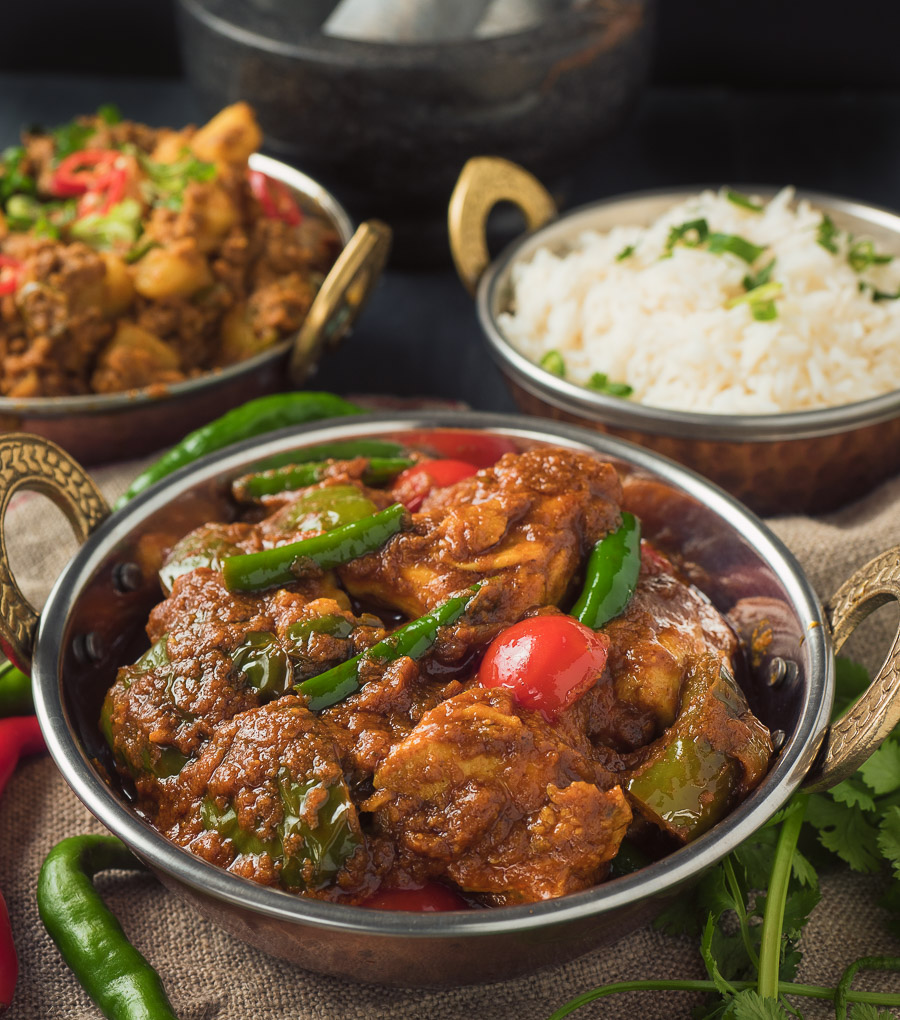
You probably know some of the ingredients already
To make any curry you will probably need to make a trip to a really good grocery store. Or more likely an Indian food store. Some you may already know. Some you may not.
Cinnamon bark (cassia) – you can substitute cinnamon stick. It’s about the same.
Green cardamom – this is the whole spice. You should be able to get it pretty much anywhere.
Coconut milk powder – this is a key ingredient in many South Indian dishes. Maggi is a pretty common brand. It comes in boxes. You can substitute coconut milk.
Tandoori masala – this comes in boxes and jars. It’s tandoori seasoning complete with the red colour. It’s used in some curries. You can also use it to make a quick tandoori marinade. Not a bad one to have around. Get it at Indian grocery stores.
Garlic ginger paste. You can make it or you can buy it. It’s easy to make and homemade tastes way better.

Some you may not be so familiar with
Mix powder – this is the house spice base in the restaurant. It’s a mix of pretty common spices. It’s house-made curry powder. You can use mine or you can come up with your own. All the recipes in this blog are tested with mine.
Kasoor methi – this is dried fenugreek leaves and they use it in pretty much everything. This one I expect will require a trip to an Indian market. It comes in small boxes.
Panch phoran – Bengali 5 spice. You can buy this pre-mixed or make it yourself. It is equal portions of cumin seed, brown mustard seed, nigella seed, fenugreek seed and fennel seed. The spices are whole. It is not meant to be a powder.
Madras curry powder – this is used in a few of the hotter curries.
Kashmiri chili powder – this is a pretty mild chili powder that imparts a bright red colour. Cayenne is much hotter. You can try substituting 1/4 cayenne with 3/4 paprika.
Black cardamom – this is a whole spice. It’s bigger than green cardamom and has a bit of a smoky flavour. Get it at Indian grocery stores.
Curry base – this is the secret to making Indian restaurant curry. You can make a batch of it and freeze it in ziplock backs or small containers. You can’t make this style of curry without curry base.
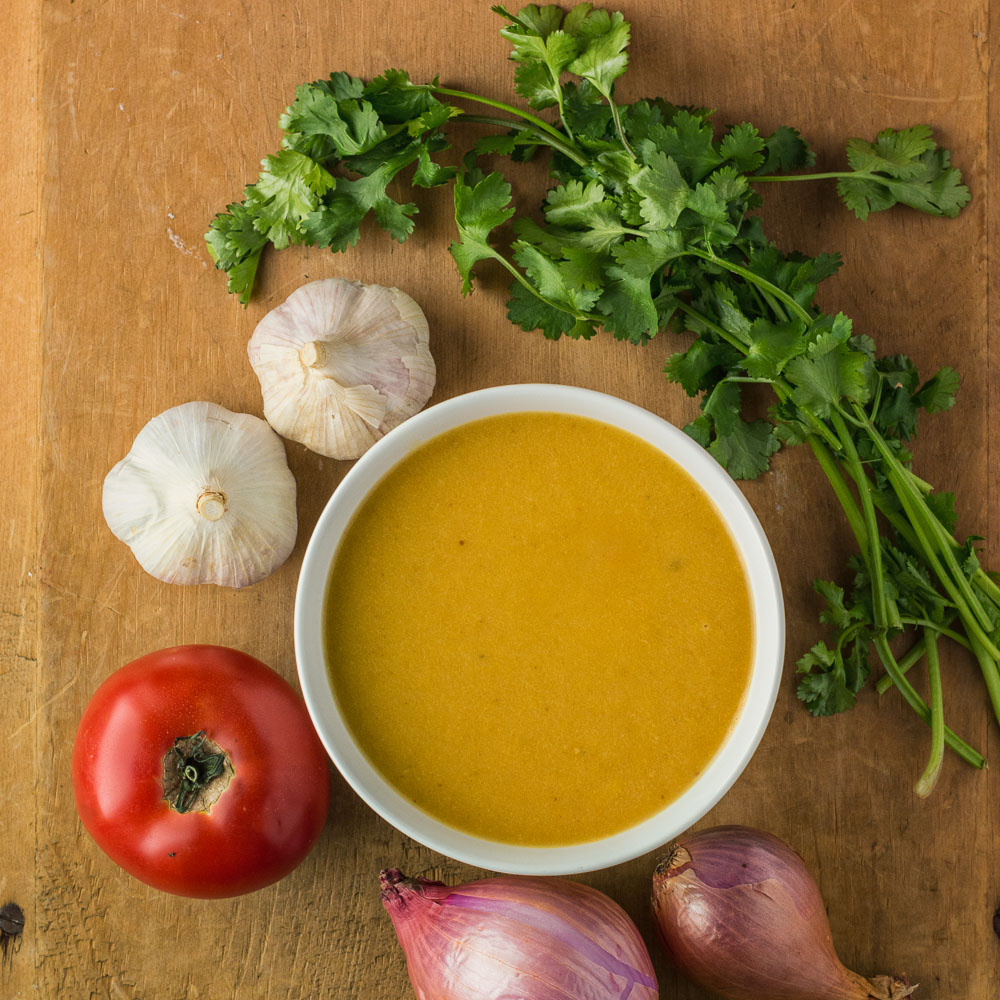
Curry leaves – these are not what curry powder is made from. Think of it as an herb. It’s popular in South Indian cooking and it’s worth seeking out. It’s only good fresh. Dry tastes like nothing. If you can’t get fresh, leave it out. Get it at Indian grocery stores.
Pre-cooked meat – cooking in this style relies on having the meat or poultry pre-cooked. That’s the other secret. Even the vegetables are pre-cooked.
Restaurant style curry means your poultry or meat is pre-cooked
This isn’t a big deal. It’s a time saver really. It also prevents the liquids from the meat diluting your curry. There’s flavour in those juices. That’s true. Everything is a tradeoff…
For chicken, simply cut up the boneless chicken (I like thighs) into big bite size chunks. Put them in a pan with a teaspoon or so of curry powder, add salt to taste then cover in chicken stock.
Simmer until the chicken is just barely done. It will cook another 5 minutes when you cook the curry.
For lamb or beef, cut the meat into big bite size chunks. Brown the meat as you would for stew. Add some curry powder and salt, then cover with stock.
Simmer until tender – about an hour for lamb and two hours for beef. You can freeze the lamb or beef so you don’t have to do this every time. I use a food saver. Works great.
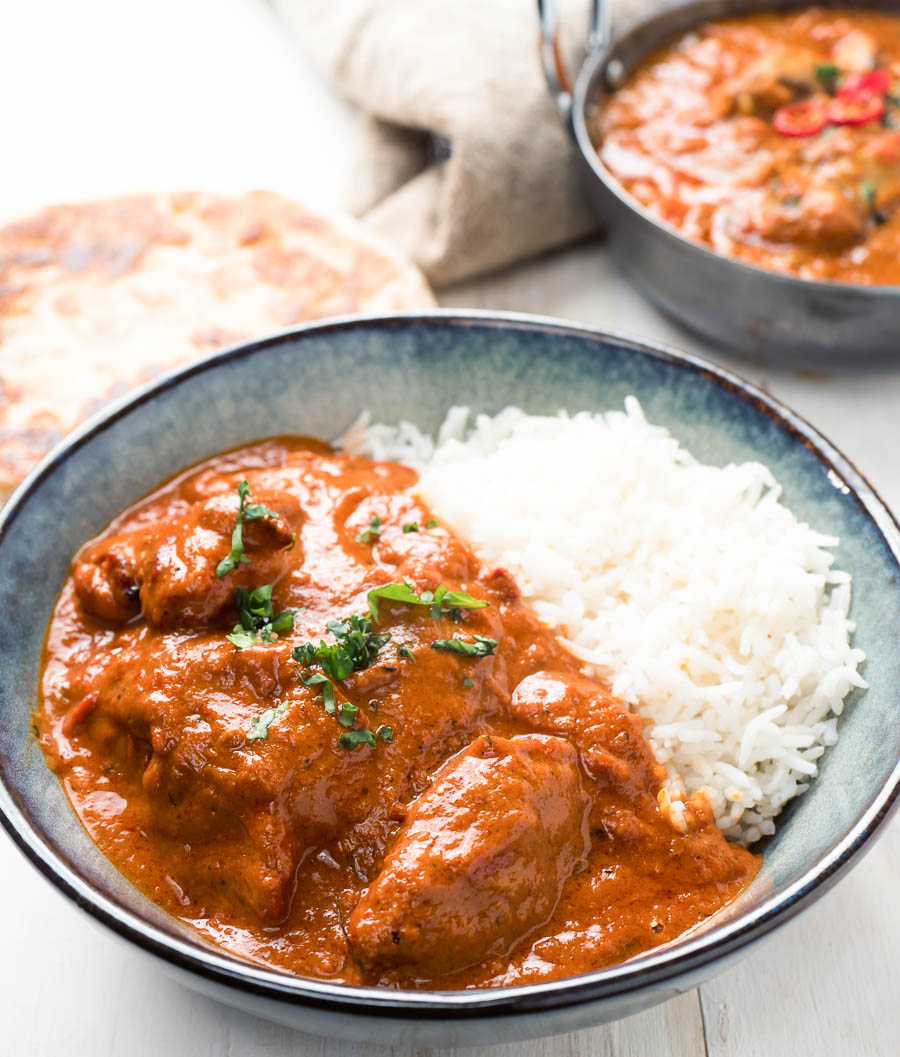
The gear
You don’t need anything particularly fancy. A cheap 10 1/2 inch aluminum skillet is nice have. You can get those at a restaurant supply store for next to nothing.
Aluminum conducts heat almost as well as copper so it works well. Being able to control heat is pretty important when you are making Indian restaurant curry at home.
A roughly 6 ounce ladle is handy as well. The recipes typically call for 6 oz of curry base at a time. If you get into this seriously and start surfing the forums recipes often read “add a ladle of curry base”.
Some small bowls for your prepped ingredients is another nice to have. That’s about it.
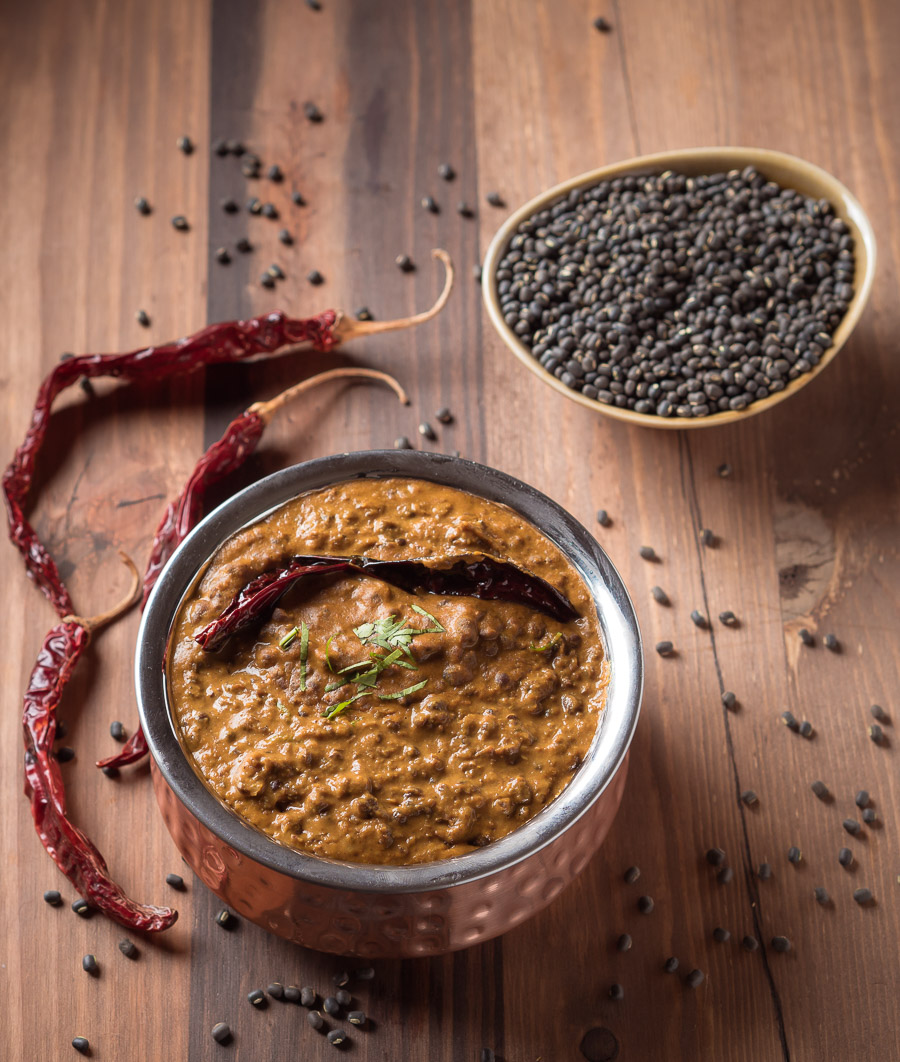
How to cook Indian restaurant style curry
Indian restaurant style curry is all about prep and technique. You may screw up the first couple times. As long as you don’t burn the spices, your screw ups will still be really, really good. Probably as good as your local Indian restaurant.
When you get it though, you will be head and shoulders above all but the best Indian restaurants in town. When you get this you will amaze your friends. You will amaze yourself!
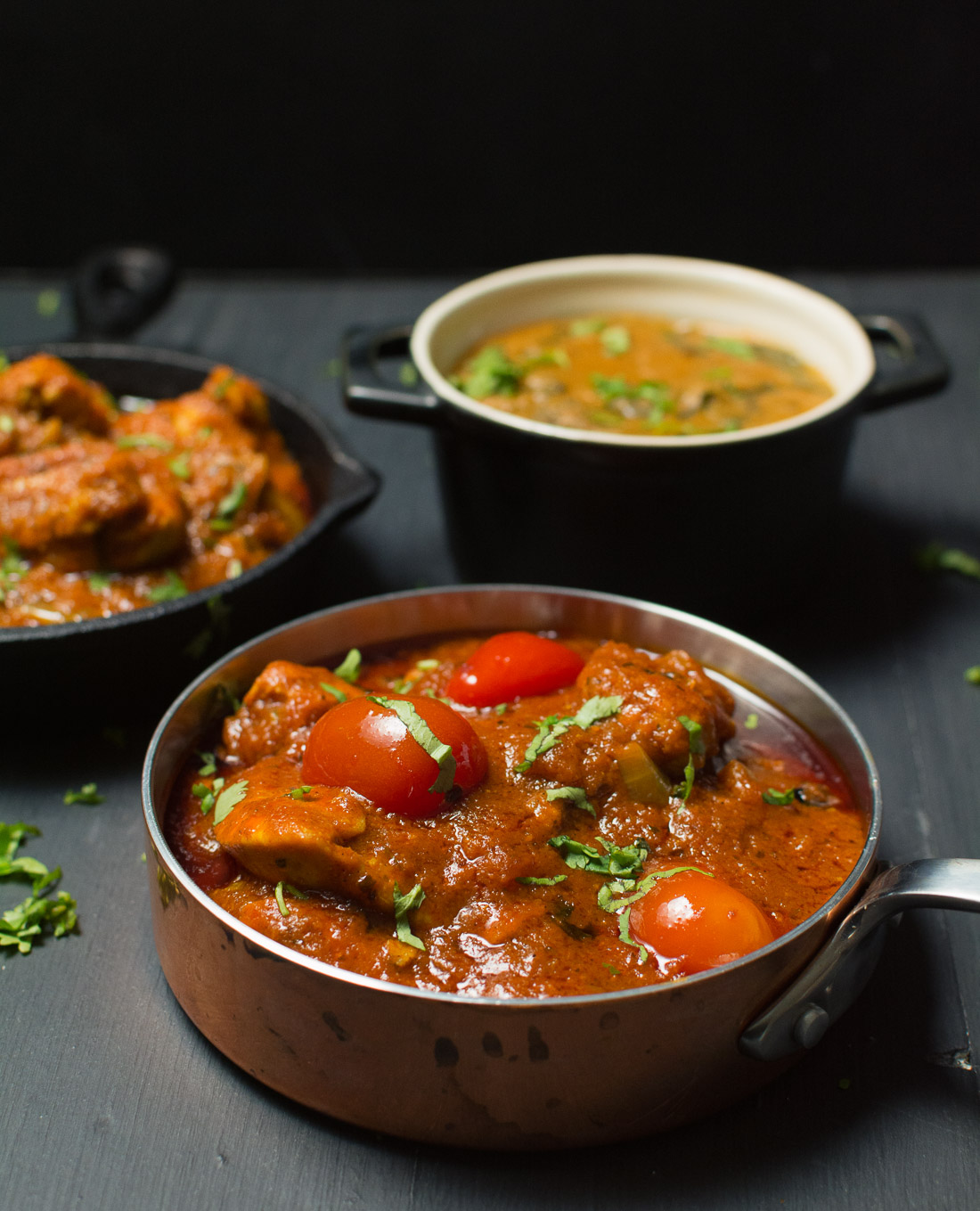
Do your prep
Chop any onions, cilantro, tomato etc that you need. Mix your tomato paste with water. Have your garlic ginger at the ready. Combine the dry powdered spices in a small bowl. In another bowl ready your whole spices (cardamom, cinnamon stick, bay leaf etc).
Prepare your coconut powder by mixing it with water. Read your recipe carefully and understand what you are doing before you start.
Pre-heat your curry base. If you are cooking one curry, you can heat it in the microwave. If you are cooking a feast keep it simmering on the stove.
This technique relies on caramelizing the onions in the base. The base needs to be hot for this to work. I don’t understand why this is important. But it is. I’ve tried with cold base. It doesn’t work.
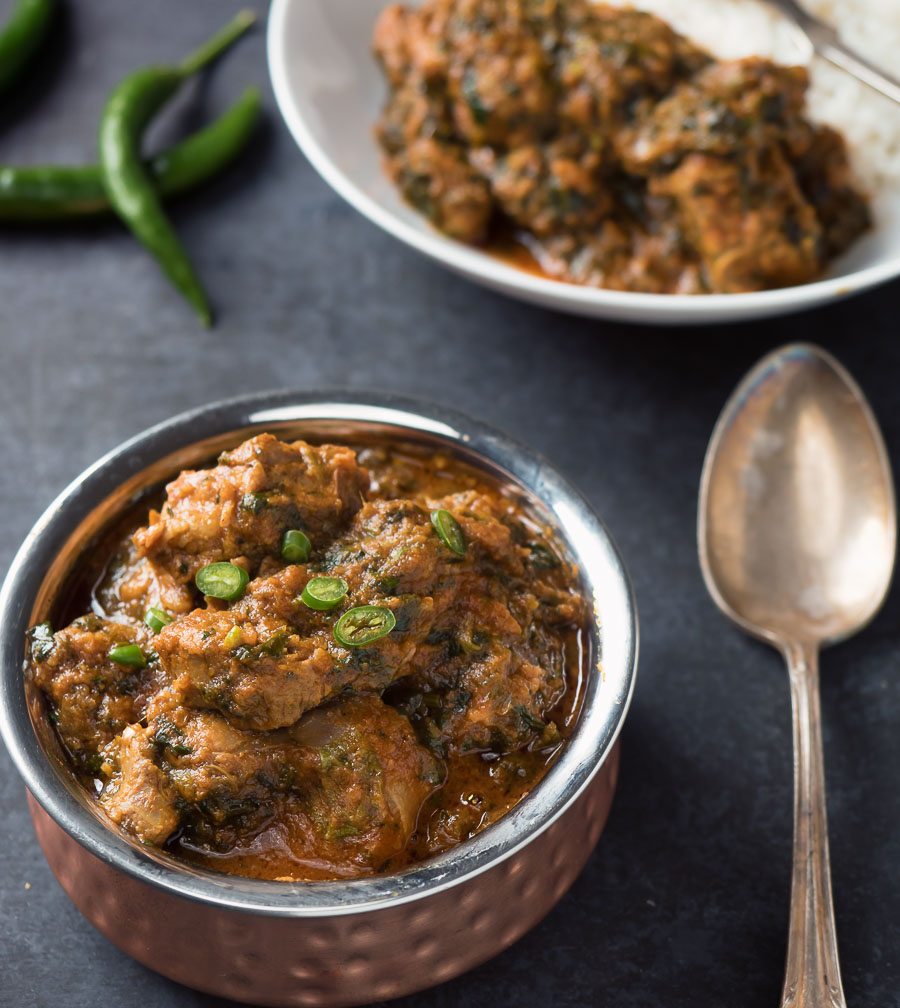
Cook the curry
Read this once to get familiar. It’s worth it to get your groove. The general directions to cook curry are also found in each Indian restaurant curry recipe.
Pre-heat your pan over medium heat. A gas stove helps but it’s not essential. Add the oil to the pre-heated pan. You want to see it shimmer but not smoke like crazy. If it smokes, stop and let it cool a bit.
If the Indian restaurant curry recipe calls for whole spices they go in first. Just for 10 or 15 seconds. That’s all it takes. They will start to crackle a bit. If the recipe called for diced onion it goes in next. Cook the onion until it’s softened and the edges just start to colour.
Add your garlic ginger paste. You want it to bubble and sputter but not burn.
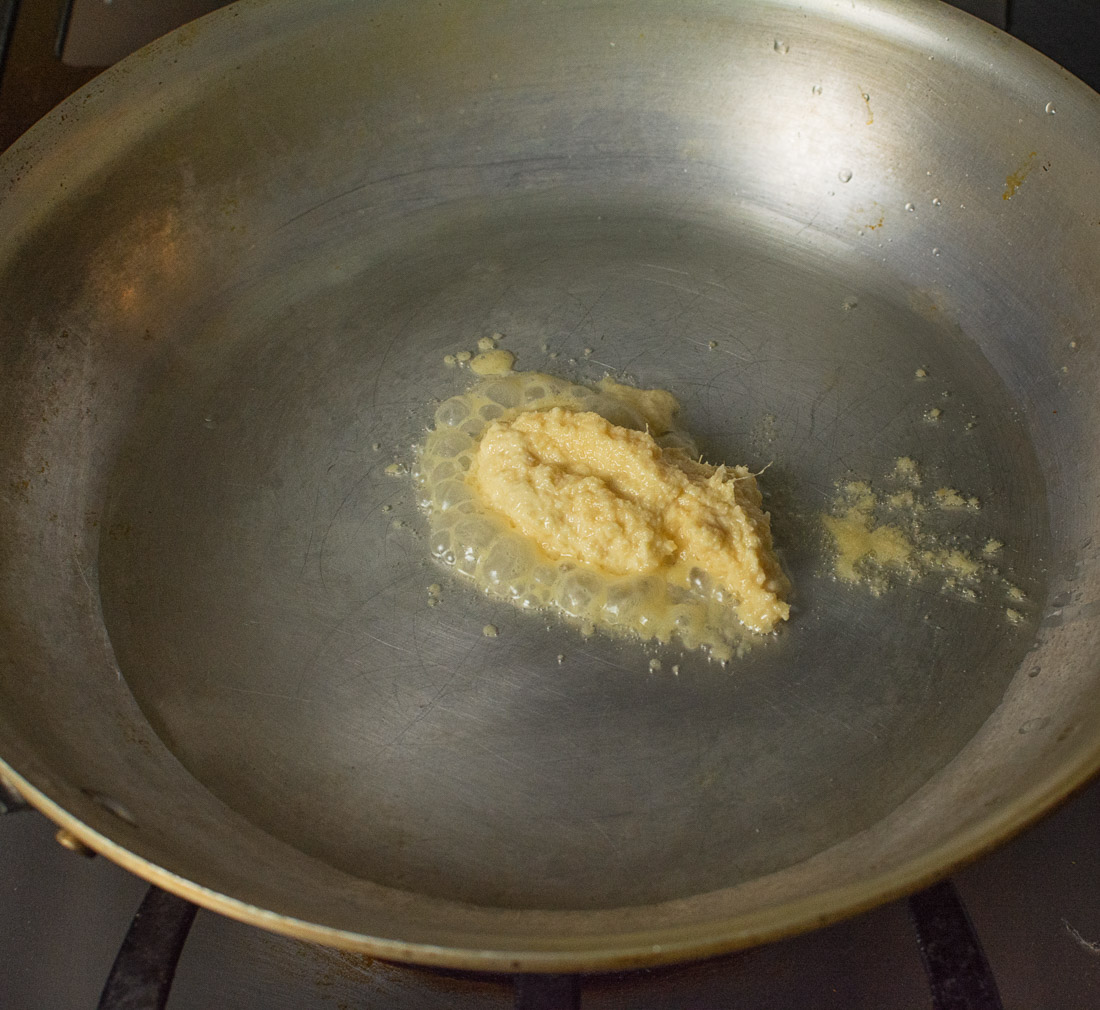
Getting the heat right is critical when you add your spices
When it stops sputtering (30 seconds or so) turn down the heat and add the dry, powdered spices. Some recipes may have you add the kasoor methi first and everything else shortly after.
This is the critical step when cooking Indian restaurant curry at home. Stir constantly. If the spices look like they are at risk of burning turn the heat down. If you have an electric cooktop pick the pan up off the heat. You don’t want to let the spices burn but you do want them to cook through.
Cooking the spices will get rid of the raw spice taste. If the spices burn, just chuck everything and start again. There’s no fixing that. It will happen to you. It did to me at least.
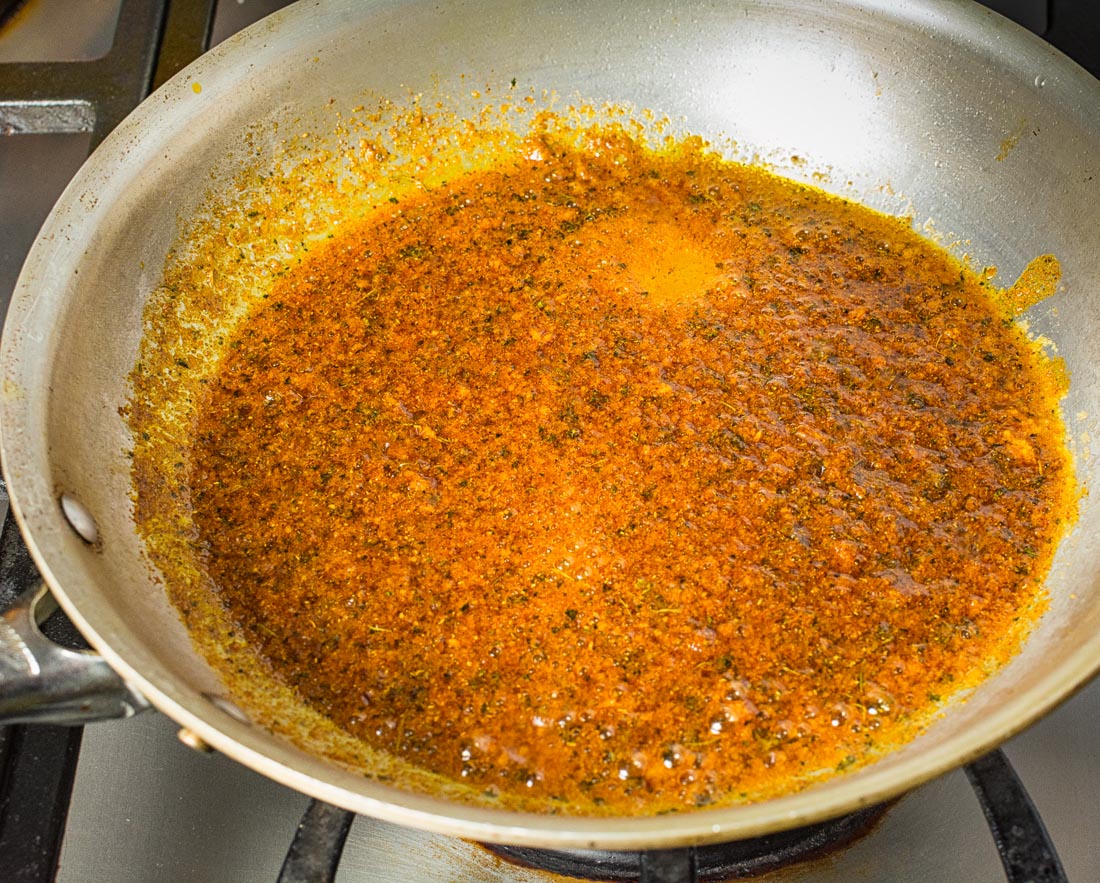
After cooking the spices for about thirty seconds, add the tomato paste water mix and turn up the heat. If the recipe doesn’t call for tomato paste add a splash of curry base.
Stir constantly until bubbles form. The oil may separate at this point. That’s good. You want that. This takes about 30-45 seconds.
The curry base is where the magic happens
Next comes about 3 oz (half a ladle’s worth) of curry base. Add it in and give it a stir. Cook it until the bubbles form again. This takes anywhere between 30-60 seconds.
Now add about 6 oz (a full ladle) of the curry base. Cook it, stirring occasionally, until the bubbles form again. This takes around 90 seconds, depending on your heat.
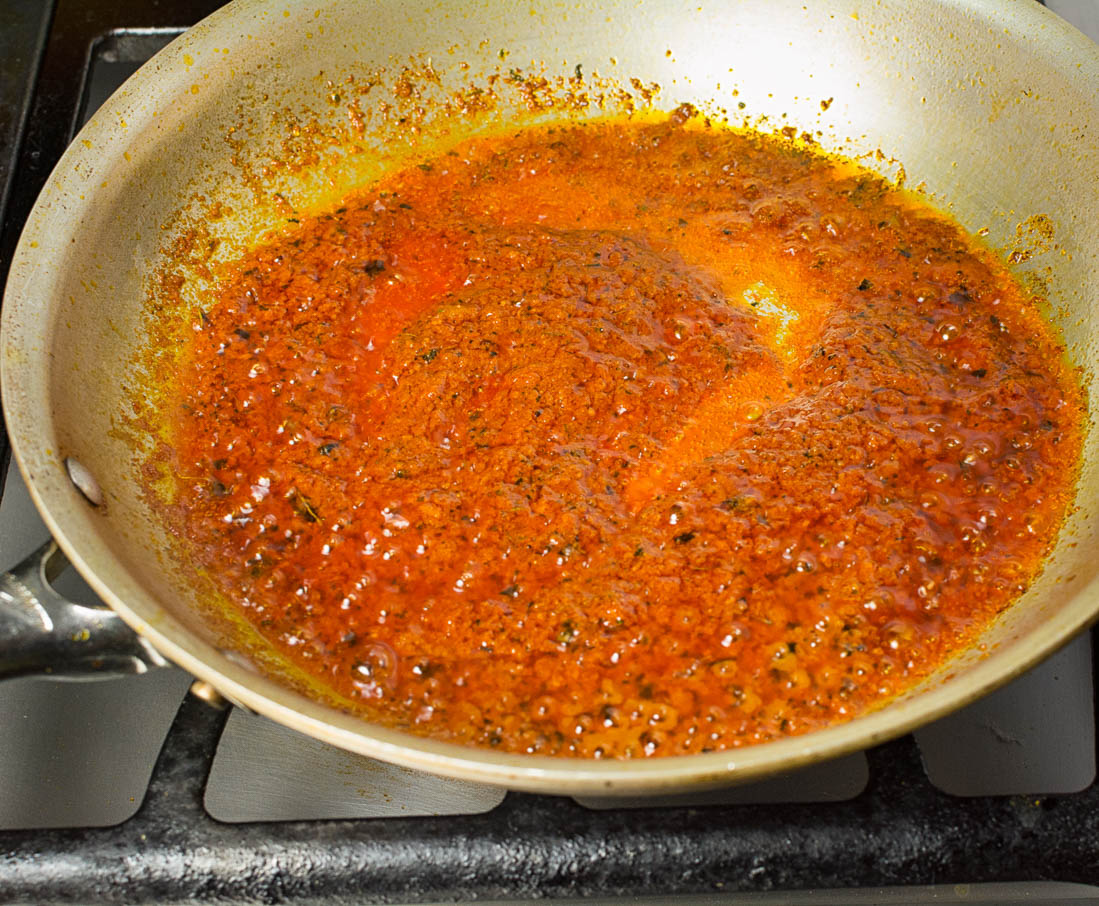
Add a second full ladle and repeat. When the bubbles form, turn the heat down to a simmer.
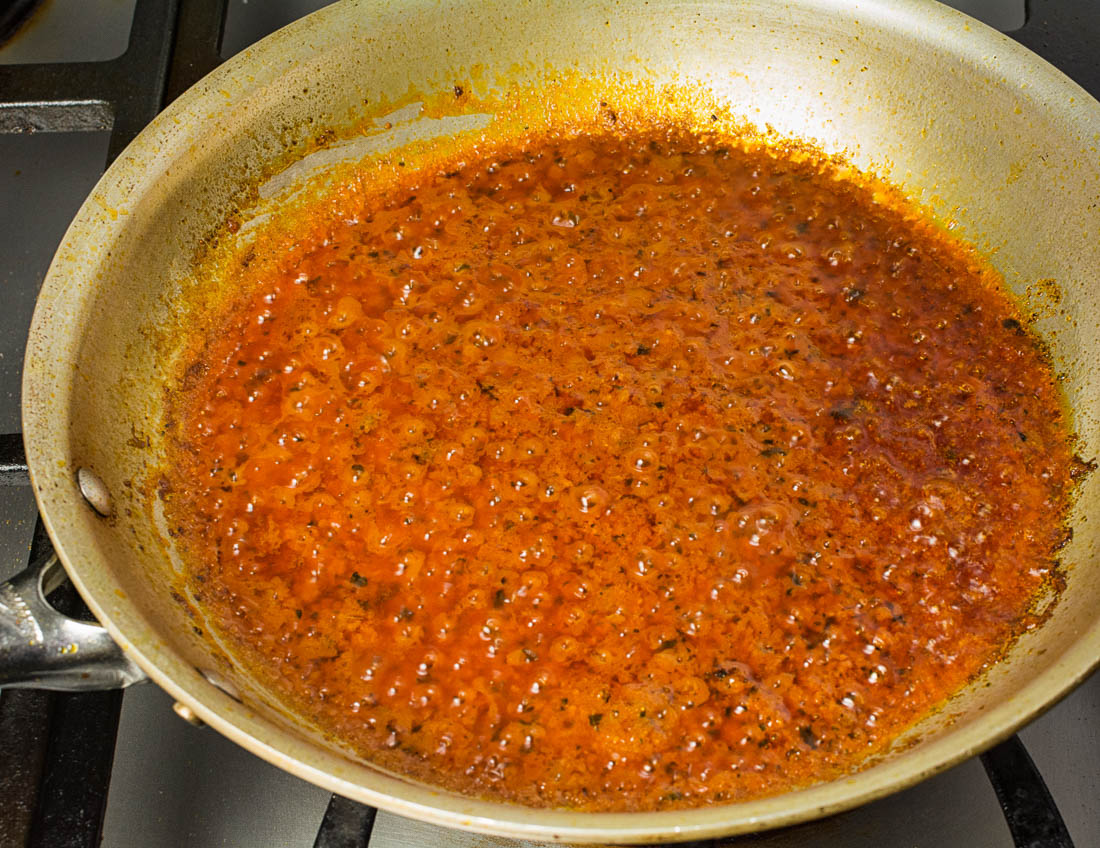
Now comes the pre-cooked meat or vegetable portion Usually, it’s around 8-10 oz of meat per curry. Add it in and stir. Let simmer a few minutes.
At this point add in the finishing touches (lemon juice, coriander leaf, garam masala, coconut milk etc). Give it a final stir, check for salt and serve your Indian restaurant curry with rice, naan or chapatis.
That’s it. It may seem a bit daunting at first but you can do it. You’ll be cranking out really impressive Indian restaurant curry at home in no time!
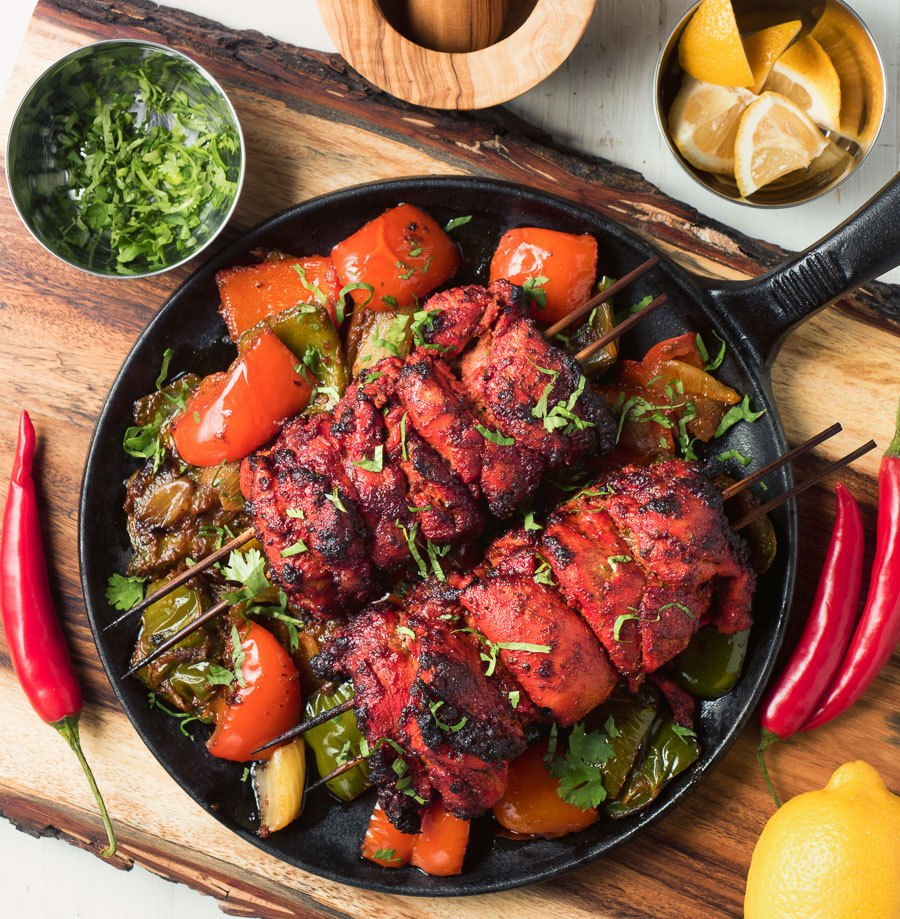
Related recipes
There are many Indian restaurant curries on the this site and more are being added all the time.
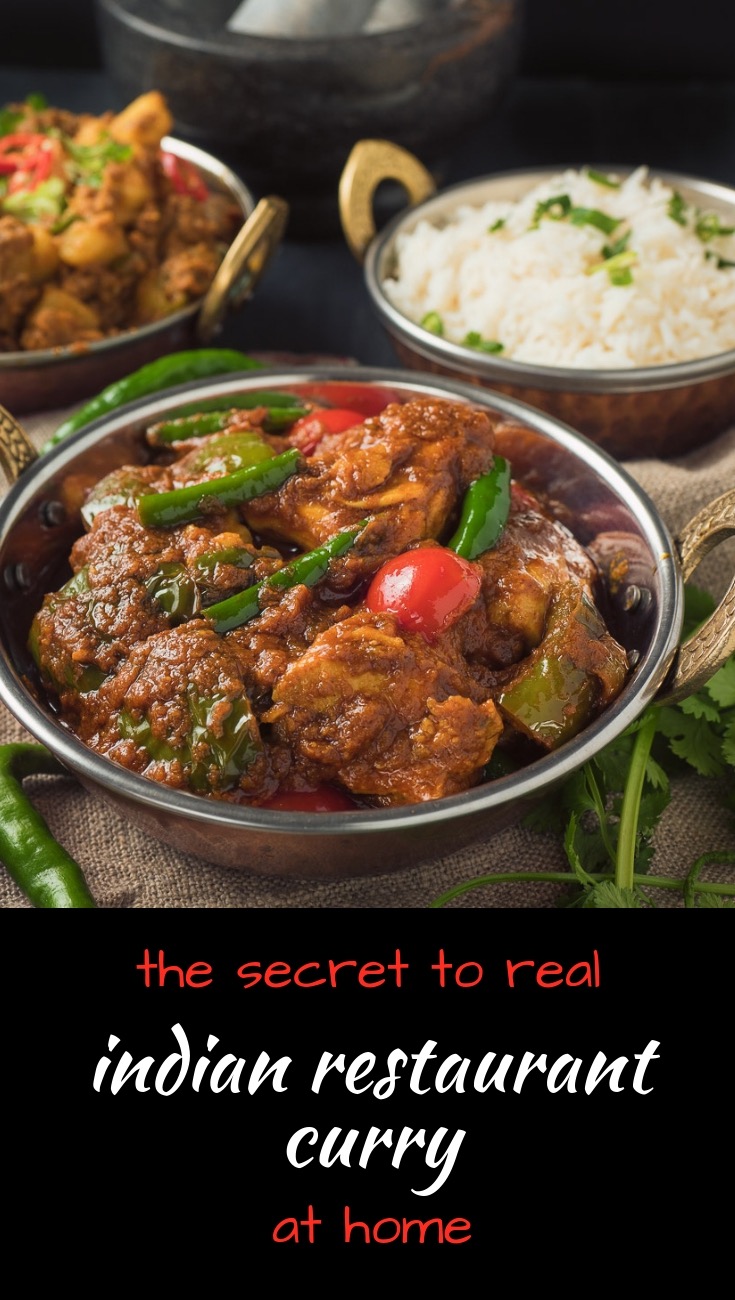

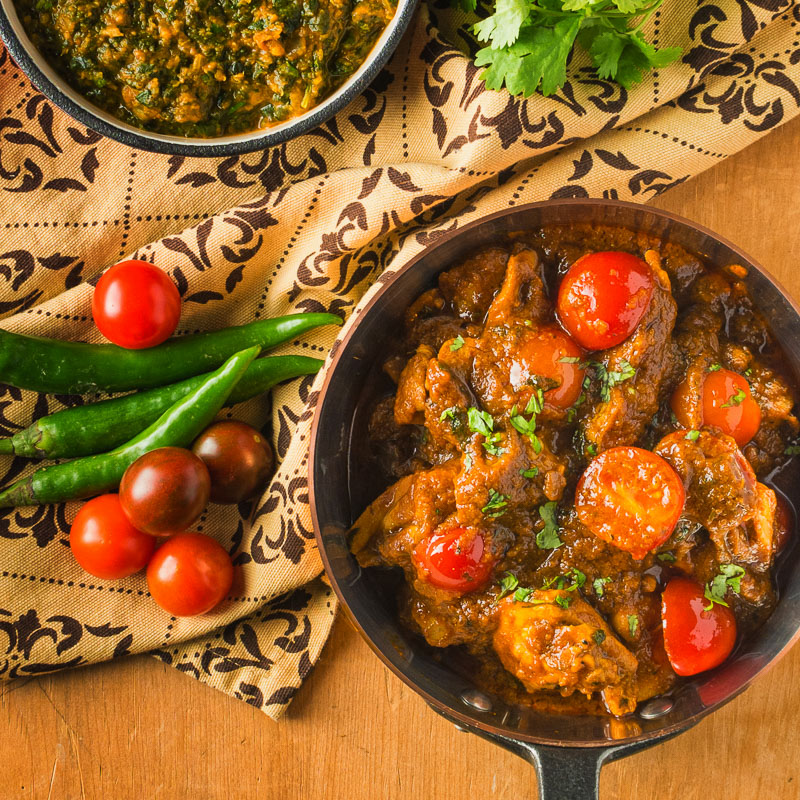
Where is the video?
‘This video should help you get started
Start by watching this video. It’s short. Once you’ve seen it everything below should make more sense. Read the post and come back and watch the video again. It will all make sense. I promise.’
But there is no video?
Don’t know why you are experiencing this. I just tested this in chrome and safari as well as chrome on a phone and it worked on all three…
This video should help you get started
There does not seem to be a link to this video.
The video is embedded in the post?
Made a believer out of me. I discovered Glebe Kitchen here just this past weekend, spent half of Saturday making curry base, and made one of the restaurant-style curries with leftover Thanksgiving turkey. So good. I can’t wait to try more curries. Freezing the curry base in portions makes the prep time miniscule.
Awesome! It’s so much fun cooking this way. A bit of work up front but like you said – once you have the curry base it’s a snap.
We have now made our 12th different variety of your curries, every one a winner! Because our kitchen is small and unsociable when entertaining because it isn’t close by, I have been wondering if you (or anyone else) has frozen any of the curries and then when defrosted, just reheated in a casserole dish in oven or on hob. Would like to serve some of these curries to friends without having to leave them for half an hour!
12 different curries! I’m going to have to post some more soon.
I haven’t frozen curries myself but I have heard lots of people do so I think it should work out just fine. My kitchen is a little isolated too so I know the feeling.
Firstly I have been cooking curries for years but your recipes and techniques are by miles the best.
My only question is, in a few recipes you use Madras curry powder and there are so many on the market. I use Bolst hot normally is this ok for these recipes.
Thanks
I love Bolsts. In fact I have reverse engineered it and posted a recipe. Madras curry powder is quite different though. I use Lalah’s brand (in the red container) but I’ve tried some others and they seem to be pretty similar.
For the first time in my life, after years and years of trying, I’ve actually managed to create an authentic, Indian restaurant style curry! Actually 4 of them! Romain, I want to thank you SO much, your resources on this website are immense. You’ve helped me end the run of countless ‘nearly there but it’s missing that Indian restaurant magic’ curries. I made these curries for a dinner party last night after religiously watch and reading your content, and can’t tell you how good it felt to finally make this breakthrough. I’d kind of given up on making proper IR curries to be honest, short of somehow getting myself in an IR kitchen and filming the process! It’s incredible how seemingly almost every cooking website out there other than yours is so far off the mark when it comes to creating authentic IR style curries… Honestly, I can’t thank you enough for the help you’ve given me, it really means a lot. I’ll be guiding every curry fan I know in this direction!!
Will – that is so nice to hear. I’m glad I could be part of your journey! You are very, very welcome. Once you get to the point you are game to serve it at a dinner party you know you’ve arrived:-).
Hi
Which cups do you use for your recipes UK Or US
Ralph
237 ml per cup.
We love these curries, Romain, though haven’t been brave enough to do the Madras! Our grandson 9, is coming to stay soon, he loves cooking, but the only curry he likes (at the moment!) is Korma, what do you suggest we add to the basic recipe to make an authentic chicken Korma.?
Thank you for saying so!
For a korma I’d suggest coconut milk, almond powder, cream and sugar. And reduce the spice to a level that makes a 9 year old happy I guess:-)
Thank you, we will try that this weekend so we can adjust it when he comes. This way of cooking has been such a help to us, my husband has always enjoyed doing some cooking, but sadly is now in early dementia, so cannot concentrate long or follow recipes. But with so much ready prepped by me, he can assemble the recipe as I pass the ingredients to him and tell him the next step. So we can still enjoy cooking together, as well as eating the delicious results. Thanks again!
Thank you. I’m so happy to be part of this!
Astonishing! My wife and I our our worst critics when it comes to home cooking and although my curry-making has never been a disaster, they’ve always been “homestyle” and not anywhere near restaurant-style. We were blown away as to how authentic the chicken bhuna and particularly the chicken dhansak dishes were (and the pilau rice). We’ve now got five containers of curry base in the freezer, a jar of restaurant spice mix and and large jar of ginger paste. Gonna try heaps of different restaurant-style dishes that we’ve not had before, then compare them to our local restaurant/takeaway. I’m simply blown away by how good the food was – cheers Romain.
Love it! Once you get a few of the “secrets” figured out there’s no stopping you. And it sounds like there’s no stopping you now! Dhansak is one of my absolute favourites so I’m especially glad you liked it.
I’m all prepped and ready to go. I would love to know what lamb would be best to use for lamb curry and the beat way to pre cook.
I like lamb shoulder (boneless or bone-in depending on your preference). For 1 lb of lamb I use a rounded teaspoon of your choice of curry or mix powder and a level teaspoon of kosher salt (maybe a rounded half teaspoon of normal table salt).
I then cover the lamb with chicken stock and give it a stir. Cover and simmer gently until the lamb is tender. Typically this takes an hour to an hour and a half but really depends on the size of the lamb cubes and how gentle the simmer is.
You can scale this up and pre-cook and freeze as well. Just remember if you are freezing it after cooking it can’t have been frozen prior to cooking as you can’t freeze proteins twice without running into texture problems.
I can’t wait to make your curry base. In the meantime, I am puzzled by the coconut powder. I’ve never used this ingredient. Do you prefer it to coconut milk? Is the flavor better or just more convenient?
Thanks!!
Alonna
It’s a little different from coconut milk but yes, it’s just handy to have around. If you have use for the rest of a can of coconut milk by all means use that if you prefer.
Fantastic curry this weekend…Have you got a good mushroom rice and pilau rice recipe? Leigh
Great to hear you are making curries you can be proud of. I haven’t done a pilau rice post but I have been asked a few times. I will put it on the list.
Just about to post myself about the apparent lack of the video too. If anyone else can’t see it either, it’s because you have an ad-blocker preventing it from ‘appearing’. I myself use Ghostery on Chrome….Paused it & re-loaded the page, and Voila…there it was! HTH…
FYI – if you are running an ad blocker you are eliminating the one and only source of revenue that funds this blog or likely any of the “free” internet services you enjoy…
Decent page load speed times costs real money…
Sounds incred, I can’t a video though?
Hmmm… works for me across 2 browsers plus phone. If it’s not playing, it is available on YouTube as well. Search glebe kitchen and you will find it.
I found it, thanks very much
Yesterday I decided to try this out. It took a couple of hours to prep the sauce, the garlic & ginger and the spice mix. I decided to be ambitious and make five dishes – especially ambitious as I only have four gas rings on my cooker!
I chose lamb dhansak, chicken jalfrezi, lamb dopiaza, a recipe I created for chicken Ceylon and the spinach & lentil dish, to which I added some paneer.
Even 75% of the way through cooking it, I was still dubious – all the dishes looked the same, and I thought that they would also taste the same. But by the time I’d finished, they were all completely different, and all completely delicious.
Total cooking time, not including the prep, was about 25 minutes, but I reckon if I only did 4 dishes I could reduce that by 5-10 minutes. It was hard work, but very rewarding.
Not only was the result just like an Indian restaurant or takeaway, it was as good as the best ones that I’ve been to. My family could not believe what I had done. Next time, I’m going to give them some home-made menus and let them choose what they want and then cook it to order.
Here’s my Ceylon recipe:
Spice mix: 2 tsp house spice mix, 1 tsp kashmiri chilli, 1 tsp kasoor methi, ½ tsp tandoori masala, ½ tsp salt.
After adding the oil, fry 1 tsp mustard seeds, 1 tsp cumin seeds, 6 green cardamom pods, 3 cloves and 1 tsp coriander seeds.
After adding the curry base add 4 Tbsp coconut powder, juice of half a lemon & 1 tsp sugar.
That’s it!
So not only can you cook from the extensive range of recipes listed on here, but it’s also really easy to reverse engineer your favourite dish based on what it says on the menu and by finding recipes online.
By the way, in the UK every restaurant has dhansak on the menu, and most places have a “chef’s specials” section where you can find unusual dishes as well as the traditional “same 15 dishes”.
Thanks for posting this, I’ve always wondered why restaurant curry is so different from what we make at home and how they cook it so quick, now I know.
Sounds to me like you are becoming a curry master!
Thank you so, so much for all the time and effort you’ve put into this site. Your advice re: cooking Indian food (restaurant style) has been invaluable. Finally, it tastes like I’ve always dreamed!
You are so very welcome and I’m happy that it’s turning out for you. This is exactly why I do what I do!
Hi, Great info, I have been cooking restaurant style curries now for almost 2 years with very good results. Is there a section on this site where I can ask for advice on a particular recipe?
There are quite a few restaurant style curry recipes on glebekitchen. If there’s one in particular you are interested in by all means ask the question in the comments section of that recipe.
Oh wow! I am so happy to have found this post. I love curries and your restaurant style curry technique is going to be a game changer for me. I’ off to make a batch of curry base right now!
Enjoy!
Hi Romain – may I say I came across your recipes about 2 months ago when I was (yet again) on a quest to make a half decent curry at home in the UK, and I am absolutely blown away by this method and your recipes – it’s life changing! I have cooked the Jalfrezi a few times now and have recommended your recipes to friends, all of whom have also been really impressed – thank you for sharing!!
One question – do you have a good recipe for Tandoori Chicken at all? I would love to get a great tasting basic recipe as it’s my husband’s favourite. He’s managing ok with Jalfrezi in the meantime! 🙂
Glad it helped! I do have a tandoori chicken recipe. You can use the same marinade for chicken tikka or shashlik as well. It’s also nice with grilled lamb.
Thanks so much, I will try it as soon as possible! I made the Jalfrezi again tonight and was inspired to add homemade onion bhaji and Bombay potatoes too. A real feast ❤️
Sounds like a wonderful meal!